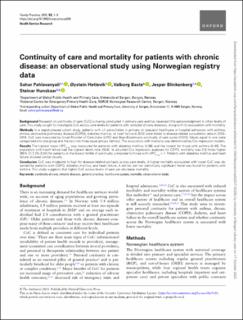Continuity of care and mortality for patients with chronic disease: an observational study using Norwegian registry data
Journal article, Peer reviewed
Published version

View/
Date
2023Metadata
Show full item recordCollections
Abstract
Background
Research on continuity of care (CoC) is mainly conducted in primary care and has received little acknowledgment in other levels of care. This study sought to investigate CoC across care levels for patients with selected chronic diseases, along with its association with mortality.
Methods
In a registry-based cohort study, patients with ≥1 consultation in primary or specialist healthcare or hospital admission with asthma, chronic obstructive pulmonary disease (COPD), diabetes mellitus, or heart failure in 2012 were linked to disease-related consultation data in 2013–2016. CoC was measured by Usual Provider of Care index (UPC) and Bice–Boxermann continuity of care score (COCI). Values equal to one were categorized into one group and the rest into three equal groups (tertiles). The association with mortality was determined by Cox regression models.
Results
The highest mean UPCtotal was measured for patients with diabetes mellitus (0.58) and the lowest for those with asthma (0.46). The population with heart failure had the highest death rate (26.5). In adjusted Cox regression analyses for COPD, mortality was 2.6 times higher (95% CI 2.25–3.04) for patients in the lowest tertile of continuity compared to those with UPCtotal = 1. Patients with diabetes mellitus and heart failure showed similar results.
Conclusion
CoC was moderate to high for disease-related contacts across care levels. A higher mortality associated with lower CoC was observed for patients with COPD, diabetes mellitus, and heart failure. A similar, but not statistically significant trend was found for patients with asthma. This study suggests that higher CoC across levels of care can decrease mortality.
